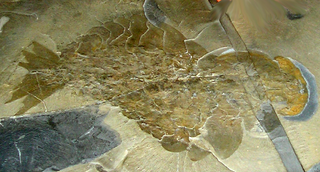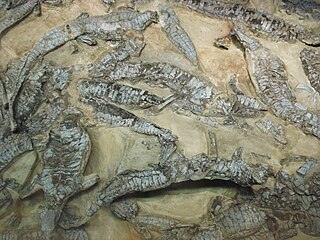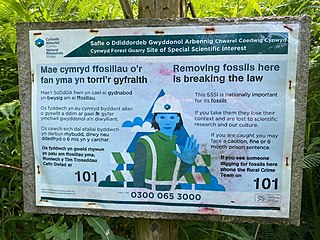
Trilobites are a group of extinct marine arthropods that form the class Trilobita. Trilobites form one of the earliest-known groups of arthropods. The first appearance of trilobites in the fossil record defines the base of the Atdabanian stage of the Early Cambrian period, and they flourished throughout the lower Paleozoic before slipping into a long decline, when, during the Devonian, all trilobite orders except the Proetida died out. The last extant trilobites finally disappeared in the mass extinction at the end of the Permian about 252 million years ago. Trilobites were among the most successful of all early animals, existing in oceans for almost 270 million years, with over 20,000 species having been described.

The pygidium is the posterior body part or shield of crustaceans and some other arthropods, such as insects and the extinct trilobites. In groups other than insects, it contains the anus and, in females, the ovipositor. It is composed of fused body segments, sometimes with a tail, and separated from thoracic segments by an articulation.

Asaphida is a large, morphologically diverse order of trilobites found in marine strata dated from the Middle Cambrian until their extinction during the Silurian. Asaphida contains six superfamilies, but no suborders. Asaphids comprise some 20% of described fossil trilobites.

The Phacopina comprise a suborder of the trilobite order Phacopida. Species belonging to the Phacopina lived from the Lower Ordovician (Tremadocian) through the end of the Upper Devonian (Famennian). The one unique feature that distinguishes Phacopina from all other trilobites are the very large, separately set lenses without a common cornea of the compound eye.

Procompsognathus is an extinct genus of coelophysid theropod dinosaur that lived approximately 210 million years ago during the later part of the Triassic Period, in what is now Germany. Procompsognathus was a small-sized, lightly built, ground-dwelling, bipedal carnivore, that could grow up to 1 m (3.3 ft) long.

Anomalocaris is an extinct genus of radiodont (anomalocaridid), an order of animals thought to be closely related to ancestral arthropods. The first fossils of Anomalocaris were discovered in the Ogygopsis Shale by Joseph Frederick Whiteaves, with more examples found by Charles Doolittle Walcott in the Burgess Shale. Originally several fossilized parts discovered separately were thought to be three separate creatures, a misapprehension corrected by Harry B. Whittington and Derek Briggs in a 1985 journal article. Anomalocaris is thought to be one of the earliest examples of an apex predator, though others have been found in older Cambrian lagerstätten deposits.

Hypsibema is a little-known genus of dinosaur from the Late Cretaceous. Its giant fossils were found in the U.S. states of North Carolina and possibly Missouri. It is believed to be a hadrosauroid, although the Missouri remains were first thought to belong to a small sauropod.

Isotelus is a genus of asaphid trilobites from the middle and upper Ordovician period, fairly common in the Northeastern United States, northwest Manitoba, southwestern Quebec and southeastern Ontario. One species, Isotelus rex, is currently the world's largest trilobite ever found as a complete fossil.

Aetosaurus is an extinct genus of pseudosuchian reptile belonging to the order Aetosauria. It is generally considered to be the most primitive aetosaur. Three species are currently recognized: A. ferratus, the type species from Germany and Italy; A. crassicauda from Germany; and A. arcuatus from eastern North America. Additional specimens referred to Aetosaurus have been found in the Chinle Group of the southwestern United States, and the Fleming Fjord Formation of Greenland. Specimens of Aetosaurus occur in Norian-age strata.

The bushy-tailed mongoose is a mammal in the family Herpestidae found in central Africa, from southern Kenya to central Mozambique.

The thick-tailed pygmy jerboa is a species of rodent in the family Dipodidae. It is found in China, Kazakhstan, and Mongolia. Its natural habitats are temperate grassland and temperate desert. It is threatened by habitat loss. It is listed by the IUCN as being "least concern".
A number of assemblages bear fossil assemblages similar in character to that of the Burgess Shale. While many are also preserved in a similar fashion to the Burgess Shale, the term "Burgess Shale-type fauna" covers assemblages based on taxonomic criteria only.
Atractopyge is a genus of trilobites that lived in what would be Asia and Europe from the middle Ordovician to the early Devonian from 472 to 412.3 mya, existing for approximately 59.7 million years.

Charles Emerson Beecher was an American paleontologist most famous for the thorough excavation, preparation and study of trilobite ventral anatomy from specimens collected at Beecher's Trilobite Bed. Beecher was rapidly promoted at Yale Peabody Museum, eventually rising to head that institution.
"Quiet, unassuming, modest in a very marked degree, simple, without affectation, entirely free from all eccentricities, conscientious and painstaking in every thing he had to do. In the words of Professor Chittenden, Director of the Sheffield Scientific School '.. .. to those who knew Professor Beecher intimately no words of appreciation will be deemed too extravagant, for close association only brought more clearly to view the many mental traits that testified to the strength of character and of mind that helped to make Professor Beecher one of the strong men of the Scientific School.' "
Bathyuriscus is an extinct genus of Cambrian trilobite. It was a nektobenthic predatory carnivore. The genus Bathyuriscus is endemic to the shallow seas that surrounded Laurentia. Its major characteristics are a large forward-reaching glabella, pointed pleurae or pleurae with very short spines, and a medium pygidium with well-impressed furrows. Complete specimens have never reached the size of 7 cm predicted by the largest pygidium found. Bathyuriscus is often found with the free cheeks shed, indicating a moulted exoskeleton. An average specimen will in addition have a furrowed glabella, crescent-shaped eyes, be semi-circular in overall body shape, have 7 to 9 thoracic segments, and a length of about 1.5 inches.

Sometimes referred to in literature as 'Bwlch y Gaseg' and in very close proximity to the area named as such on OS Map 1888-1913, the Cynwyd Forest Quarry is a Site of Special Scientific Interest (SSSI) located aside a track within the Cynwyd Forest near Corwen, Denbighshire, North Wales. It was described by Rushton et al. (2000) and exposes Late Ordovician micaceous siltstones and mudstones of the Dolhir Formation which yields a rich shelly (brachiopod) fauna. Trilobites are represented by several genera although the fauna is dominated by Gravicalymene arcuata Price, 1982. Bivalves, bryozoans and various Echinodermata are also present. Examples of most of the fossils listed below are illustrated and briefly described in "Fossils of the Upper Ordovician" by Harper and Owen (Eds.).
Bumastus is an extinct genus of corynexochid trilobites which existed from the Early Ordovician period to the Late Silurian period. They were relatively large trilobites, reaching a length of 6 in (15 cm). They were distinctive for their highly globular, smooth-surfaced exoskeleton. They possessed well-developed, large compound eyes and were believed to have dwelled in shallow-water sediments in life.

Illaenus is a genus of trilobites from Russia and Morocco, from the middle Ordovician.
The Illaenidae are a family of trilobites in the order Corynexochida. 223 currently accepted species in 24 genera are known from the Ordovician. Some scholars include the Panderiidae in the Illaenidae, but this is not generally supported.

Illaenus tauricornis is a species of trilobites from Russia and Morocco, from the middle Ordovician.














